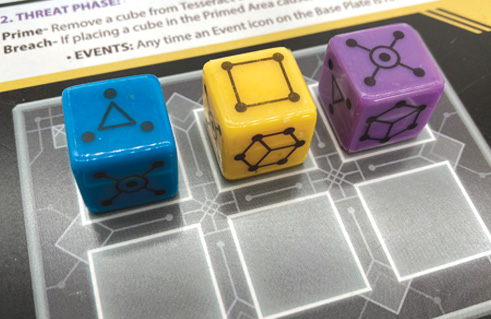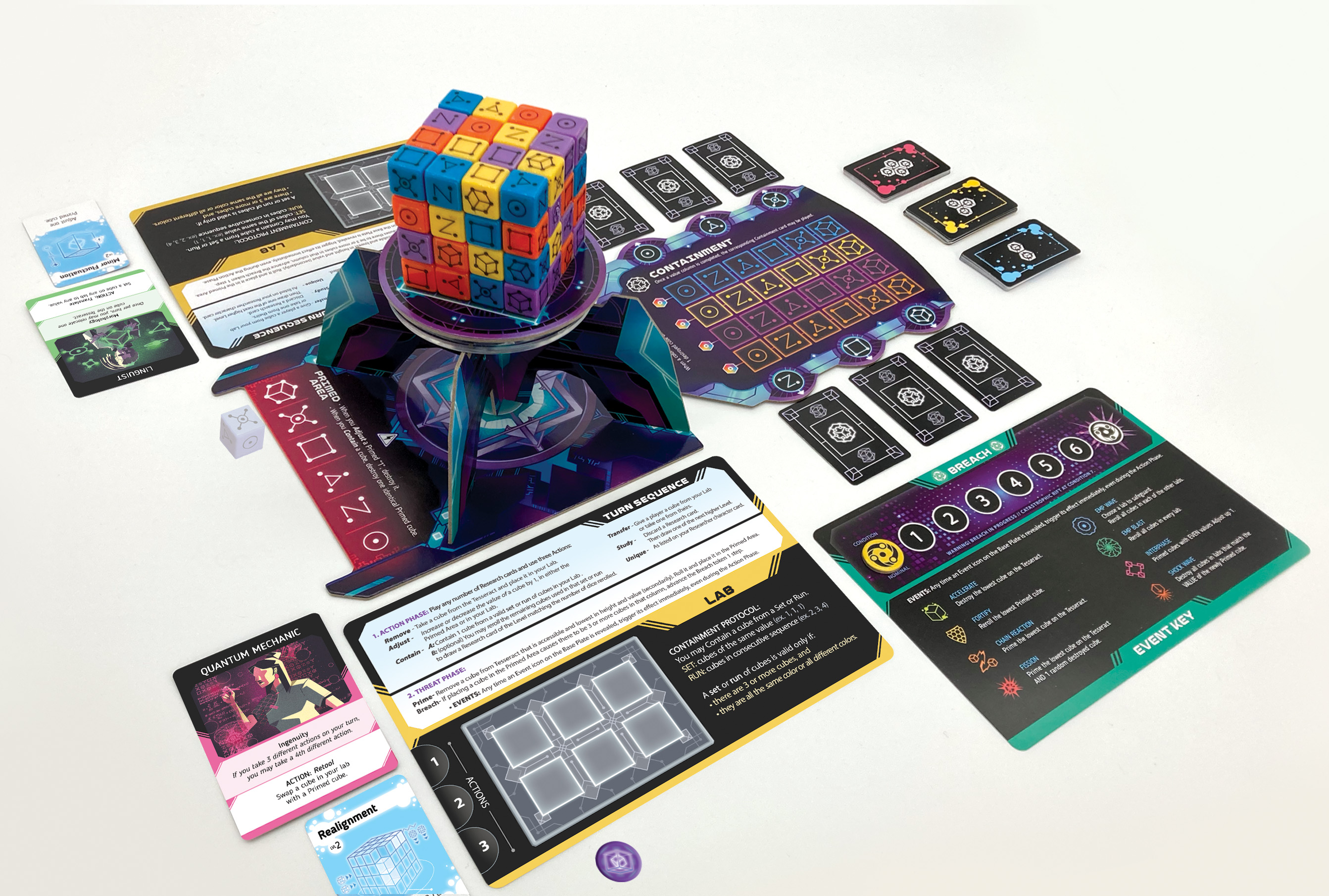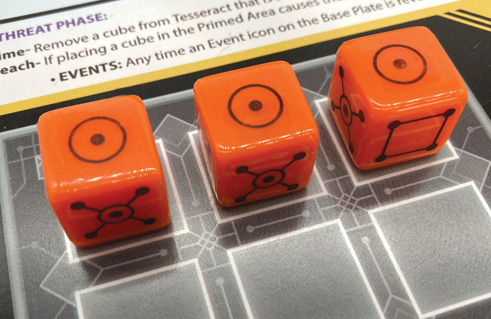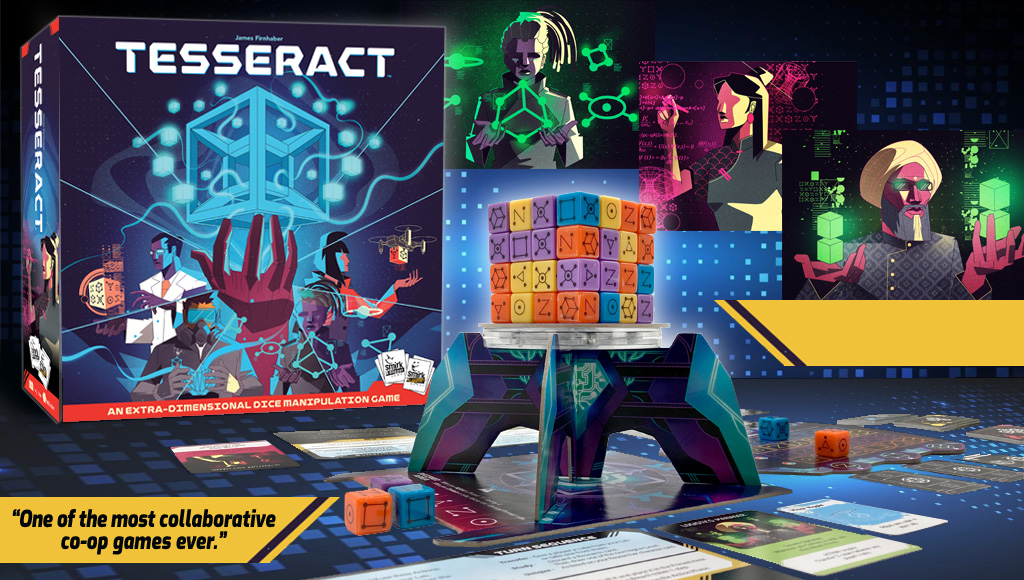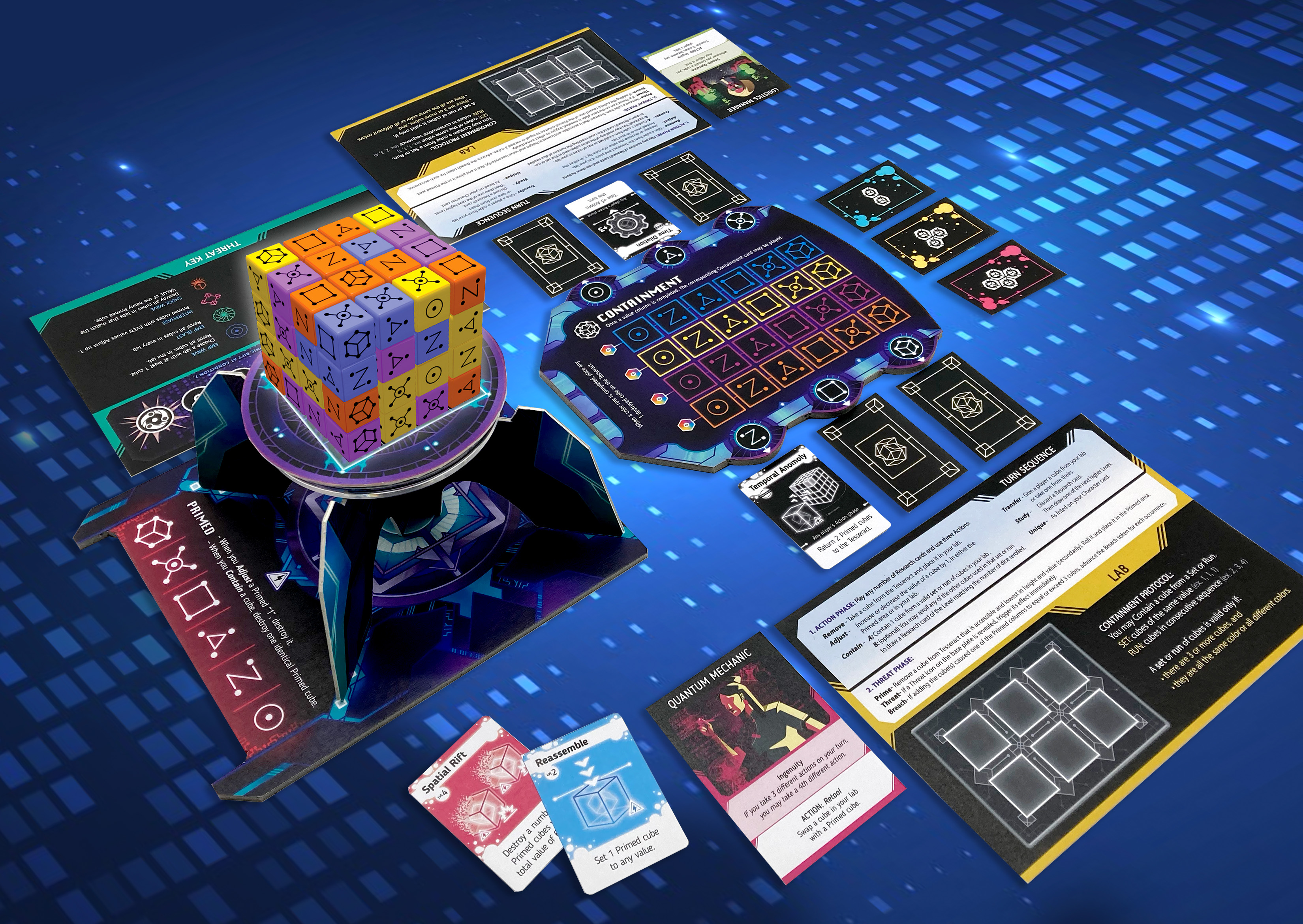
|
TESSERACT: A new dimension in cooperative games. Stunning. Intriguing. Irresistible. TESSERACT is an exciting new dice-manipulation game which sets a new bar for collaborative game play. But before we get there, I just want you to look at it on the table. The game’s centerpiece is an impressive cube of 64 colorful custom dice, emblazoned with alien iconography that give it a mysterious other-worldly feel. (But count the pips. Cleverly, they are still just numerals 1 through 6.) The cube sits above the table on a dimensional laboratory stand -- which can be rotated 360º on a turntable so that players can view all sides! It begs to be interacted with. Yet, the turntable is not simply a gimmick. It is a smart enhancement to game play, as a clear and complete view of the dice remaining on the Tesseract is critical throughout the game. But oh man -TESSERACT showcases the raw power that table presence can have, in its ability to stop traffic and engage an audience… and few do it as well as Smirk & Dagger. Thematically, the Tesseract arrives as a fourth dimensional avatar of an extra-dimensional race – and it is priming itself to rip a hole in space/time, destroying our world with it. Unless, of course, a team of 1 to 4 scientists can manipulate the cubes and isolate them into a containment matrix before it completes its seventh breach. Researchers accomplish this by spending 3 Actions per turn to remove cubes from the Tesseract (to place into their own labs), by adjusting the value of a given cube up or down one, transferring them between players and, ultimately, by containing them into the matrix. Containment requires a researcher to have 3 or more cubes in their lab, of all one value (2, 2, 2) or a run of cubes (2, 3, 4). That set or run must be of all one color, or none of the same colors, with four colors available. This accomplished, a researcher can contain ONE of the cubes into an empty spot in the matrix. Only one cube of each color and value can be contained, so as it fills up, it becomes a bit harder to arrange. At the end of each player’s turn, the Tesseract primes itself and puts our world in peril. By slowly rotating the turntable of dice, players identify the cube that is lowest in height on the Tesseract, and if there is more than one, the lowest value cube at that height – and primes it. To prime, the cube is removed from the Tesseract, rolled and placed into the Primed area. If this adds a third cube (or more) of that value to the Primed area, it causes a dangerous breach, advancing the breach token one space closer to disaster. In addition, every time a column of cubes are removed from the Tesseract, it reveals a Threat icon on the base plate. All of the resulting effects are terrible, from simply destroying a cube to priming additional cubes immediately. Things can spin quickly out of control – and with 8 different base plates to add levels of difficulty and variability, there is a lot to constantly challenge players. One of the more interesting aspects of the game is the ability to spend actions to manipulate dice in the Primed area, mitigating the risk – while not necessarily advancing you towards a win. Do you spend your precious actions to prepare and contain cubes or prevent a possible breach? (Spoiler: It’s both!) The game includes 11 asymmetric Researchers, with both a passive “always on” ability and one unique Action only they can take. Each feels wildly overpowered, giving a sense of true agency in the game (and leaving you to wonder how winning would even be possible without you). Importantly, many of the abilities rely on other players to help you optimize your turn. Will you sacrifice an Action to help another player get more out of their turn? This quandry highlights what truly sets this game apart. TESSERACT is one of the most collaborative cooperative games on the market. Yes, all co-ops encourage teamwork, but TESSERACT pushes this aspect farther. To win, you need to discuss each player’s turn as a group to find the synergies and the opportunities to gain an edge. So there is literally no downtime. You are actively engaged at all times. You are asking for and offering help on other player’s turns. And there is so much information, between character abilities, earned Research cards, the Primed area – even the different perspectives viewing the Tesseract, that no single player can hold all the information at once. This sets up the key difference between the 4-player game and the equally exciting and challenging solo play. In solo, you will simply miss opportunities you didn’t see (but someone else might have helped with) as you try to solve the puzzle yourself. But in multiplayer, the challenge is communication and coordination of your activities. Four players who only think about their own individual turns will lose – badly. The game is truly collaborative and, all its amazing table presence aside, that is what will draw players back to play again and again. TESSERACT delivers a unique, puzzle-driven challenge that can only be won with careful planning, a little luck, and a lot of collaboration. Be sure to order your copy today at your FLGS! ••• Curt Covert is the owner of Smirk & Dagger Games and the designer of Cutthroat Caverns, Hex Hex, and Nevermore, just to name a few. For the past 20 years, he has been shaking up game tables with unique game experiences, eye-grabbing table presence and a desire sweep you up in the world of the game.
|











